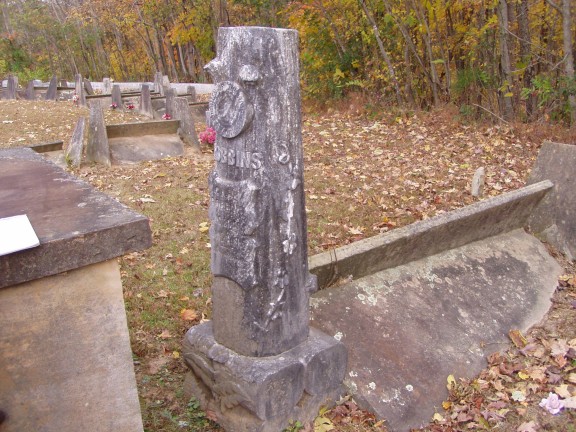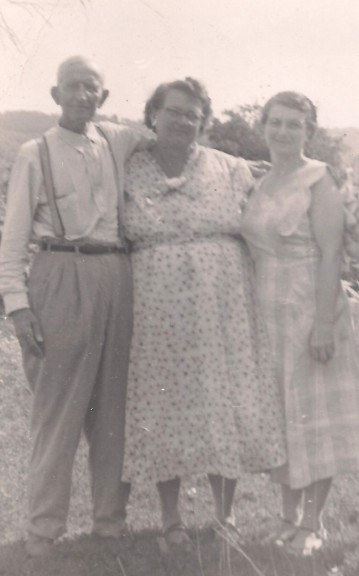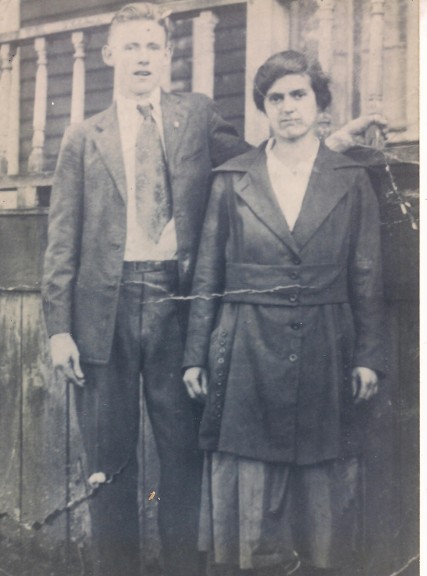Following a recent story I did about some unusual tombstones that can be found in this area, I got a call from Edith Robbins who provided "the rest of the story" in reference to a certain tree stump monument in the Falling Springs cemetery. That type of monument was once provided by Woodmen of the World Insurance. Edith had information about Carroll Robbins, the recipient of a tree stump monument in the Falling Springs cemetery. Just as some background information, here is a brief summary of why that insurance company donated these unusual markers.
The history of Woodmen of the World insurance says that prior to 1930 the erection of numerous distinctive tombstones depicting tree stumps was done across the country. The organization was founded in 1890 by Joseph Cullen Root. After hearing a sermon about "pioneer woodsmen clearing away the forest to provide for their families," he wanted to start a Society that "would clear away problems of financial security for its members." Early Woodmen certificates provided for a death and a monument benefit. Gravestones were originally furnished to members free of charge. However, during the 1920s, the Society stopped providing stone markers to members when the cost of gravestones increased and cemeteries began prohibiting above-ground markers for maintenance reasons.
Woodmen gravestones vary greatly in size and shape. Some resemble a tree stump, others a stack of cut wood. There are elaborate hand-carved monuments, simple stone markers and stake-type markers driven into the ground. A tree stump, part of the Society’s logo, is the most common symbol used on gravestone designs. Many stand approximately four to five feet high.
Although the monument benefit is no longer included in Woodmen Life Insurance certificates, the Society does not let graves go unmarked. The same Woodmen emblem is still available, fitted with pegs, for attaching to an existing stone. Regardless of its shape or size, Woodmen gravestones serve as a lasting tribute to its members and the ideals of Woodcraft. They also serve the Society’s long standing motto that "no Woodmen shall rest in an unmarked grave. Over 45,000 W.O.W. gravemarkers have been erected nationally."
The information shown on the Woodmen of the World marker in the Falling Springs cemetery contains this information: "Carl Robbins; born August 30, 1894; died June 16, 1915. Gone But Not Forgotten." According to information provided me by our County Historian Ronald Dishman, census records show that this young man’s first name was actually Carroll. Evidently the stonecutter for his marker mistakenly thought the name was "Carl." He was married, and his occupation shows that he was a miner, pulling stumps. He lost his life at the very young age of 20 years from falling rocks while working in the mines. Even though he died at a very young age, the fact that his grave has the granite tree stump marker tells us he had taken out a policy of insurance with Woodmen of the World. A tent-type monument also covers his grave.

Here is the "rest of the story" as provided by Edith Robbins:
"Carroll Robbins was 20 years old when he was killed in a mining accident. He left behind a very young wife, and that person was my mother. Her name was Elma Smith Robbins, the daughter of X.R. Smith and wife Clementine Bilbrey Smith. My mother and Carroll Robbins attended school together at Shiloh. For the rest of her life, the events of the day Carroll died remained quite clearly in her mind. She told me how, on that particular day, she heard the bell begin to ring at the mine, something that always happened when there had been an accident. When my mother heard the bell, she began walking toward the home of Carroll’s parents , Ulysses Grant Robbins and Nancy Regan Robbins, who lived in the Vine’s Ridge community. She wanted to see if they had heard what had happened. As my mother was walking to their home, she met a man on horseback. She stopped the man and asked what had happened at the mine. He told her that Carroll Robbins had just been killed, and he was on his way to tell his wife. He had no idea he was actually talking to the very person he was on his way to see. At the time of Carroll Robbins’ death, my mother was just 16 years old and was six months pregnant with a baby daughter.

Uylesses Grant Robbins and wife Elma Robbins Smith, the parents of Carroll Robbins, were photographed with their granddaughter, Sheila Robbins Wilmoth.
"After Carroll’s death, and having no way to support herself, and with a child on the way, my mother returned to the home of her parents who lived in Allred. My grandmother was ill at the time, and needed my mother’s help. My mother continued to care for my grandmother until her death. It was told that my grandmother died from T.B. of the bowels, but more than likely, it was really colon cancer. The only medication she had during her illness was laudanum." (Laudanum is potent narcotic because of its high morphine concentration, and was historically used to treat a variety of ailments. But its principal use was as an analgesic and cough suppressant. Until the early 20th century, laudanum was sold without a prescription. Today, laudanum is strictly regulated and controlled throughout the world.)
"After my grandmother’s death, my mother went back to the mining camp and worked at a hotel there. This was about 1917. She met my father, Frank A. Smith, at the mining camp and they were married on February 2, 1918. My father helped to raise my mother’s daughter, Sheila, who was three years old at the time they married, and my mother’s younger sister, Louvenia, who was 11 years old. He accepted and loved both Sheila and Louvenia as if they were actually his own children.

"As the oldest child in our large family, Sheila helped out with the births of her half-brothers and sisters as they arrived. She worked mostly inside the home. She and my mother seemed very close. My older sisters and brothers would tell how Sheila would sometimes get mad at one of them, and threaten to take away their "half" sister and give it to one of the others so she would not be related to whoever she was mad at, but would be a full sister to the one she favored at that moment. Sheila had already married and had one child when I was born, so all my memories of her were passed down to me in stories told by my siblings. I knew her only as an adult.
"When she finished elementary school at Flat Rock, a one-room school house in the Sunk Cane community, she attended a boarding high school. Sheila met the man she married when he came to teach at Flat Rock where several of my brothers and sisters were attending. His name was Perry Wilmoth, and after they married, Perry began what became a life-time of ministry work in the Church of Christ. Their family grew to include two boys, Carl and Paul, and one daughter, Mildred. Perry and Sheila lived out their married life in the Algood area. Sheila passed away around two years ago.
"My parents had a long and happy life, and together, raised a total of 11 children. My sisters and brothers along with the names of their spouses are as follows: Sheila Robbins Wilmoth - married to Perry Wilmoth; Ray Smith - married to Hallie Bowman; Nell Smith Ferrell - married to Elmo Ferrell; Madge Smith Norrod - married to Cecil Norrod; Frank Smith, Jr. - married to Clara Dean Tudor; Bernice, who died as an infant; Ruth Smith Ferrell - married Sylvester Ferrell; Billy Price Smith who died as a young man in the military; Betty Sue Smith Strong - married to Oliver Strong; Ruby Smith Sells - married to Edward Sells; and me, Edith Smith Robbins - married to Max Robbins. Of the 11 children, only one marriage ended in divorce. All the rest were long and happy marriages. I believe the way we were brought up made the odds of having a lasting marriage much better than most couples have today."
It’s always good to know how a story ends. Thank you, Edith Robbins, for contacting me and especially for sharing "the rest of the Carroll Robbins story."